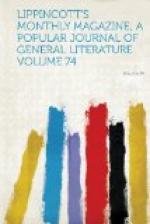[Illustration: Hampton court—looking up the river.]
Half an hour’s run lands us at Hampton Court, with a number of fellow-passengers to keep us company if we want them, and in fact whether we want them or not. Those who travel into or out of a city of four millions must lay their account with being ever in a crowd. Our consolation is, that in the city the crowd is so constant and so wholly strange to us as to defeat its effect, and create the feeling of solitude we have so often been told of; while outside of it, at the parks and show-places, the amplitude of space, density and variety of plantations, and multiplicity of carefully designed turns, nooks and retreats, are such that retirement of a more genuine character is within easy reach. The crowd, we know, is about us, but it does not elbow us, and we need hardly see it. The current of humanity, springing from one or a dozen trains or steamboats, dribbles away, soon after leaving its parent source, into a multitude of little divergent channels, like irrigating water, and covers the surface without interference.
It would be a curious statistical inquiry how many visitors Hampton Court has lost since the Cartoons were removed in 1865 to the South Kensington Museum. Actually, of course, the whole number has increased, is increasing, and is not going to be diminished. The query is, How many more there would be now were those eminent bits of pasteboard—slit up for the guidance of piece-work at a Flemish loom, tossed after the weavers had done with them into a lumber-room, then after a century’s neglect disinterred by the taste of Rubens and Charles I., brought to England, their poor frayed and faded fragments glued together and made the chief decoration of a royal palace—still in the place assigned them by the munificence and judgment of Charles? For our part—and we may speak for most Americans—when we heard, thought or read of Hampton Court, we thought of the Cartoons. Engravings of them were plenty—much more so than of the palace itself. Numbers of domestic connoisseurs know Raphael principally as the painter of the Cartoons.
A few who have not heard of them have heard of Wolsey. The pursy old cardinal furnishes the surviving one of the two main props of Hampton’s glory. An oddly-assorted pair, indeed—the delicate Italian painter, without a thought outside of his art, and the bluff English placeman, avid of nothing but honors and wealth. And the association of either of them with the spot is comparatively so slight. Wolsey held the ground for a few years, only by lease, built a mere fraction of the present edifice, and disappeared from the scene within half a generation. What it boasts, or boasted, of the other belongs to the least noted of his works—half a dozen sketches meant for stuff-patterns, and never intended to be preserved as pictures. Pictures they are, nevertheless, and all the more valuable and surprising as manifesting such easy command of hand and faculty, such a matter-of-course employment of the utmost resources of art on a production designed to have no continuing existence except as finished, rendered and given to the world by a “base mechanical,” with no sense of art at all.




